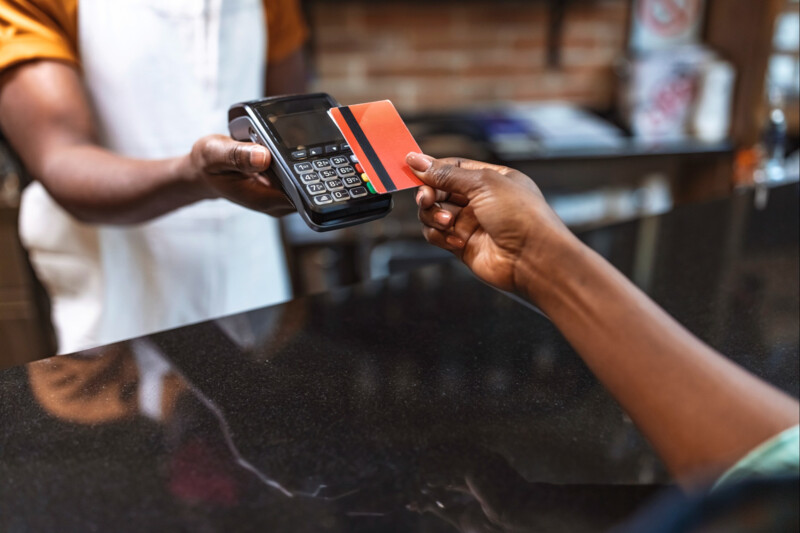Dans le commerce, l'encaissement en liquide se raréfie. De plus en plus, avec le développement du numérique, d'autres moyens de paiement voient le jour. Il y a bien sûr la carte de crédit, devenue incontournable depuis longtemps, mais également les paiements via smartphone, porte-feuille électronique, e-mail et SMS. Pour être en mesure de répondre aux besoins de ses consommateurs, qui ont l'habitude d'acheter sur internet et d'utiliser les nouvelles technologies, l'entreprise doit s'équiper de solutions d'encaissement appropriées. Il existe sur le marché de nombreux outils, qu'il s'agisse de matériels comme de logiciels. De la caisse enregistreuse classique au terminal de paiement en passant par l'application sur un mobile, les choix sont multiples. À chacun de les adapter et de les optimiser selon son activité.

Quelles sont les solutions d'encaissement ?
Nous ne pouvons pas citer toutes les solutions d'encaissement ici. Regardons donc les plus courantes, qui sont les 5 suivantes.
1. Les caisses enregistreuses
La caisse enregistreuse est un système d'encaissement très répandu dans les petits commerces et la restauration. Elle possède un tiroir-caisse pour le stockage de la monnaie et traite maintenant souvent le paiement par carte de crédit.
Les fabricants proposent des caisses très performantes : tactiles, connectées, synchronisées, équipées de logiciels de gestion... Tout est fait pour fluidifier les transactions.
2. Les terminaux de paiement
Le terminal de paiement électronique (TPE) est un appareil capable de lire une carte bancaire, y compris sans contact ou sur mobile et d'enregistrer la transaction. Les données sont transmises à la banque qui transfère ensuite l'argent sur le compte du commerçant. Les TPE se sont modernisés et intègrent à présent d'autres fonctionnalités tels que des logiciels de gestion des stocks ou des logiciels de comptabilité.
3. Les encaissements sur mobile
Accepter des paiements par carte bancaire peu importe l'endroit où l'on se trouve est possible grâce à un petit boitier connecté à son smartphone ou à sa tablette. Il suffit de s'équiper d'un lecteur de carte fourni par un organisme financier, puis de télécharger l'application gratuite.
4. Le paiement en ligne
Paylib, PayPal, Stripe, Apple Pay, entre autres, sont des moyens de paiement permettant aux internautes qui souhaitent acheter en ligne depuis un mobile, une tablette ou un ordinateur, de régler leurs achats. La transaction est sécurisée autant pour l'acheteur que pour le vendeur. Le processus d'achat est rapide et simplifié, car il n'est pas nécessaire de saisir à chaque fois ses données bancaires.
5. Le monnayeur automatique
Aucune intervention humaine n'est requise. L'appareil se charge de calculer le montant à payer, de récupérer le règlement en espèces ou par carte, de rendre la monnaie et en plus, il détecte les faux billets. Gain de temps et sécurité garantis.
Comment optimiser les solutions d'encaissement ?
Chaque secteur possède ses propres spécificités. Avant tout, il faut déterminer les besoins de l'entreprise. Ensuite, choisir un outil adapté au type d'activité.
Dans un tabac presse, par exemple, les opérations d'encaissement doivent être rapidement exécutées. Le système choisi sera simple, pratique et devra accepter différents modes de paiement.
Un marchand ambulant ne pourra plus longtemps se passer d'un lecteur de carte de type Smile&Pay car les clients de passage n'ont pas toujours du liquide sur eux en cas d'achat coup de cœur.
Les restaurateurs favoriseront les logiciels de caisse plus sophistiqués, leur permettant aussi de gérer leurs stocks ou leurs réservations en temps réel. Par contre, ils veilleront à ce qu'ils soient faciles à prendre en main par un personnel en constante rotation.
Les marchands d'e-commerce éviteront les abandons de paniers avec une solution claire et rapide de paiement.
Quel que soit le genre d'activité exercée, les principaux critères de sélection à retenir sont :
- la simplicité d'installation et d'utilisation
- la possibilité de personnaliser en fonction de son métier
- la garantie d'un gain de temps
- le prix par rapport aux fonctionnalités réellement nécessaires
- les périphériques adaptables
- l'assistance après-vente
Pour sélectionner la meilleure solution d'encaissement, il peut s'avérer utile d'en tester plusieurs. La plupart des prestataires proposent des périodes d'essai. Les outils trop généralistes sont généralement décevants à l'usage. Tous les aspects, autant techniques que pratiques ou financiers sont donc à examiner.
